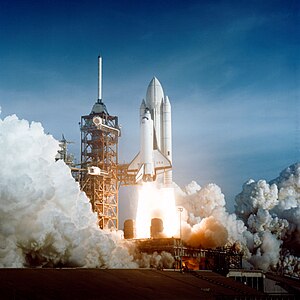It was the summer of 1969, and Armstrong’s landing on the moon was a knock-out punch by the American’s against the Russians in the space race. Earlier, the Russians had held the lead, by putting their Sputnik spacecraft into orbit.
 Image via Wikipedia
Image via Wikipedia
The space race has fizzled, and become a joint-venture of sorts, as countries across the globe work together to better space exploration. Canadian astronauts have gone up on Space Shuttle missions – there are two in space now on one.
Several countries have partnered to build the International Space Station. And without good working relations among the nations of the world, we wouldn’t have the high tech global telecommunications systems which we enjoy, allowing us to place voice, video, data and text calls from Dildo, Newfoundland & Labrador, Canada (yes that place exists), to Twatt, Scotland (that place exists too).
Still, forty-years after NASA put a man on the moon, we have yet to really better that achievement. Yes, the Space Shuttles are far more advanced than the rocket ship which propelled Armstrong to our closest orbiting body, but we have yet to venture back to the moon, or the other celestial bodies within our solar system.
Humans have sent robotic rovers to Mars, and satellites far beyond our solar system. These have given us a glimpse into what lies beyond our cozy atmospheric-creature-comfort planet Earth. But despite that initial knock-out punch, man (or woman) have never set foot on any other land mass outside since.
NASA is working on it – they have announced plans to go to the moon by 2020, and establish a lunar base capable of sustaining living conditions for six-months on the moon by 2025. This would allow astronauts to build a home from which to study the terrain and working conditions in space, to prepare for trips beyond the moon.
That trip beyond the moon could very well be Mars.
A trip to the red planet would take six-months, as Mars is over 30-million miles away from Earth. The moon is a great way to test the technologies needed to get humans that far out into space, and to establishing actual home-bases from which to work.
Makes sense, if it takes you six-months to get someplace, you don’t want to just do a quick hop-skip and jump on the surface, then turn around and spend another six-months coming back. You want to stay, look around, and explore the unknown.
 Image by Getty Images via Daylife
Image by Getty Images via Daylife
Although it’s been so long since human beings walked on the moon, NASA is taking the trek to the moon and later Mars seriously. Last month, the American space agency launched their Lunar Reconnaissance Orbiter, an unmanned spacecraft to find potential landing sites based on moon surface resources.
Currently, NASA is investigating the moon’s south pole, because of the possibility of water ice, which could be used by the astronauts living there for drinking, or as a source of oxygen and hydrogen for air and fuel.
Once astronauts have conquered the living conditions on the moon, in theory, they would be better prepared for a mission to Mars.
Big plans, but riddled with a big hole. Just next year, NASA is retiring the Space Shuttle fleet, and their new rocket ship – the Orion – won’t be ready for another five-years. That means American astronauts – and presumably Canadian ones as well – will have to depend on Russia’s Soyuz spacecraft to
 Image via Wikipedia
Image via Wikipedia
"Relying on the Russians between when we're retiring the shuttle and having the Constellation program flying is something that I'm not very proud of," said former Kennedy Space Center Director Bob Crippen, who piloted the first space shuttle mission in 1981.
Crippen, and many others feel it is great to be partners in space exploration with Russia and other countries, but it isn’t good to be totally dependent on another country’s spacecraft to get you to where you want to go.
Crippen has argued that the Space Shuttles could fly safely until the Orion – or some other NASA vehicle – is ready, but NASA says it is more about money than safety. They simply don’t have the money to continue the shuttle program while developing other space technologies.
It’s been forty-years since man has walked on the moon, so it probably won’t hurt us any if we have to wait a few more years. Still, putting a space colony on the moon won’t be nearly as exciting as putting one on Mars, which will take even more time to achieve. But both will be well worth the wait.
![Reblog this post [with Zemanta]](http://img.zemanta.com/reblog_b.png?x-id=fc7ce72f-0e51-4059-9c39-43346c311e9d)








No comments:
Post a Comment